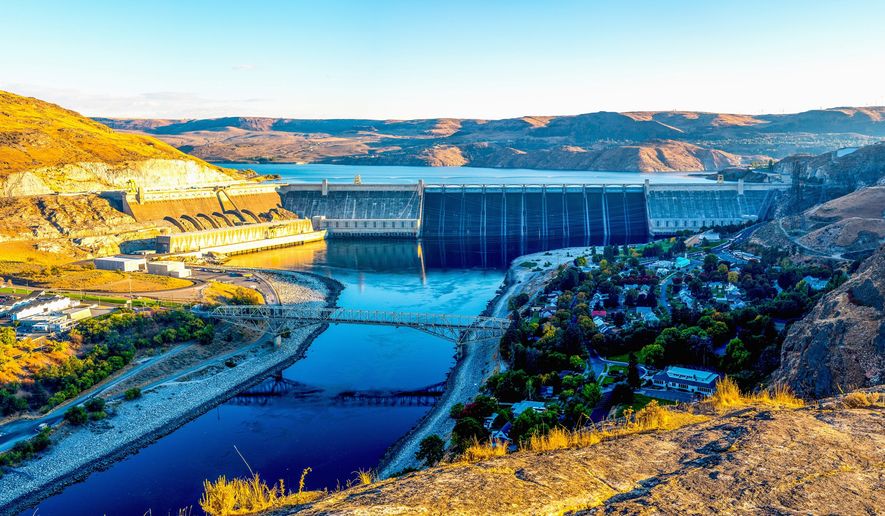OPINION:
When many Americans hear “infrastructure,” they think of roads and bridges. In Central Washington, we think of water.
Unlike western Washington with its record-breaking rainfall, we boast more than 300 days of sunshine east of the Cascades Mountains, which results in a dry, arid climate and — more often than not — drought.
Water storage, delivery and conservation are at the forefront of our minds, and our federal water infrastructure, from hydroelectric dams to irrigation canals, needs attention. Much of our water infrastructure has not been improved or updated for decades — some as long as a century — and crumbling, outdated infrastructure can have dire consequences for our way of life.
In the Pacific Northwest, hydropower dams generate clean, renewable energy to supplement our all-of-the-above energy portfolio. In addition to a myriad of other benefits, we rely on dams of all sizes to deliver what little water we have to municipalities and to growers and producers in one of the country’s most diverse agricultural regions.
The Grand Coulee Dam, located in Washington’s 4th Congressional District, is operated by the Bureau of Reclamation (BOR) and remains the largest power-producing hydroelectric dam in the country. Reservoirs from Grand Coulee serve as the backbone of the Columbia Basin Project, a BOR project first authorized in 1943 that supplies irrigation to 10,000 farms throughout the Columbia Basin and greatly contributes to flood control and navigation of our rivers.
The third phase of the Yakima Project, which was authorized in the lands package signed into law earlier this year, aims to better serve the needs of Central Washington’s agricultural community, conservationists and local communities by improving delivery of our region’s most precious resource: water.
Without investment, these projects will fail, and life as we know it in my congressional district and in many communities across the West will cease to exist.
In May, I led a letter with California Democrat Rep. Jim Costa, signed by more than 50 of our colleagues in Congress, urging the inclusion of much-needed water infrastructure provisions in any forthcoming infrastructure package. Regions across the country — including Central Washington — are facing severe hydrological challenges, from accessing clean drinking water to critical water storage and delivery projects that fuel our rural communities and agriculture industries.
Needless to say, as we continue to watch our nation’s water infrastructure crumble, there is strong bipartisan support to provide a solution.
We have not yet seen a comprehensive package from the House Transportation and Infrastructure Committee, but that does not mean we haven’t made progress.
I introduced the Water Supply Infrastructure Revitalization and Utilization Act to address the BOR maintenance backlog at water supply infrastructure projects and empower local water operators to improve and update existing infrastructure projects.
The bill helps water managers access funds and provides the flexibility they need to repair and rebuild aging BOR facilities across the country, ensuring our existing surface storage facilities are operating as efficiently as possible. By creating a revolving Aging Infrastructure Account and a clearly defined application and review process, local water users can initiate maintenance projects with extended repayment.
Like much of our nation’s crumbling infrastructure, aging dam infrastructure requires regular maintenance and upkeep. The “Safety of Dams” program aims to improve the structural integrity of our nation’s dams, and it is vital for ensuring all BOR dams continue to operate safely and efficiently. The legislation increases the program’s authorization cap to meet BOR’s projected funding needs for the future workload.
Finally, the bill creates a pilot program to give more flexibility to reservoir operators. Communities across the West know the impacts of droughts all too well, and this legislation allows operators to temporarily store water in dedicated flood control space during certain low-risk times of the year.
The Water Supply Infrastructure Revitalization and Utilization Act is a strong step forward, but it is just a step. Congress must invest in our nation’s infrastructure, and as we consider ways to improve and modernize failing and outdated structures across the country, we cannot forget about the water infrastructure our rural communities and agriculture industries rely on. I will continue to work with my colleagues to maintain and strengthen water infrastructure in Central Washington and across the country.
• Rep. Dan Newhouse, a Republican, represents Washington’s 4th Congressional District. He serves on the House Appropriations Committee, including the Subcommittee on Energy and Water Development. He is a third-generation Yakima Valley farmer and previously served as the Director of Washington State’s Department of Agriculture.




Please read our comment policy before commenting.